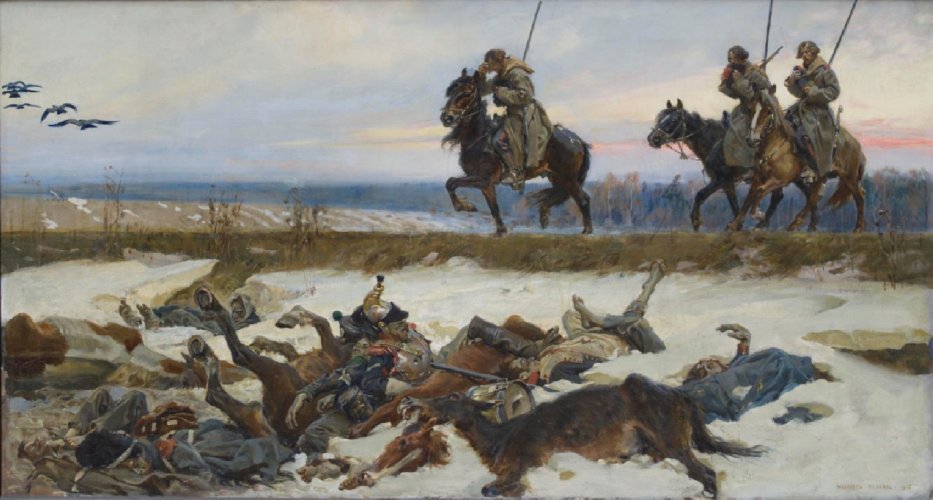Description:
Wojciech Kossak (1856-1942) studied at the Academy of Fine Arts in Krakow between 1871 and 1874, and then at the Munich Academy, where he made friends with the Polish artistic colony. From 1877 to 1883 he pursued further studies at the École des Beaux–Arts in Paris. Living in Krakow permanently, he often traveled around Europe. From 1915 he was a professor of battle painting at the Academy of Fine Arts in Warsaw. He exhibited his works in Poland and at foreign Salons for years. His father Juliusz Kossak and his friend Józef Brandt had a great influence on his art. He often painted battle scenes, hunting scenes or portraits of riders and horses. Already popular in his youth, he painted around 2000 paintings. He worked with oil, watercolors and illustrations for magazines with which he collaborated.
Description of the painting:
This painting is part of a series called “Napoleonic“, in which, alongside depictions of the Emperor, the artist captured soldiers wandering through winter wastelands. The work “Spring 1813 in Russia“ is the first version of this theme. The second, larger composition was purchased in 1908 by the Lviv Picture Gallery. Both are considered to be the most interesting canvases from the Napoleonic series.
The work depicts a group of three hussars in retreat after Napoleon‘s failed invasion of Russia. They ride across the plain covered with melting snow. They are dressed in characteristic dark blue–red hussar uniforms, parts of which are visible under long coats. They are armed. At the sides they have sabers, on the backs long lances. One of them, suspended through the frame, has a rifle. The men hold hats in their hands, which they took off as a sign of respect for the fallen, shown in the foreground. The melting snow revealed the bodies of the fallen soldiers – hussars, members of an elite military unit. The figures are mixed with the corpses of horses. Arranged unnaturally, contorted, with grimaces on their faces.
The image is kept in a mood of horror, defeat and omnipresent death. Despite the season – spring, the melting snow reveals not the first signs of life, but the corpses of the fallen. The backdrop for the scene is a boundless field and a strip of clouded sky with bloody glimmers, on which the lost remnants of the Great Army of Napoleon are drawn. Fear and a sense of hopelessness and disbelief, whether they will survive, are painted on the faces of the chilled men. The horses are also full of expression. Their silhouettes reflect the terror of the sight that makes them flee. Fear is visible in their eyes. The crows and ravens, shown at the left edge of the painting, frightened by the presence of the soldiers, rose from the realistically depicted corpses of men and horse carcasses.
The image is kept in a mood of horror, defeat and omnipresent death. Despite the season – spring, the melting snow reveals not the first signs of life, but the corpses of the fallen. The backdrop for the scene is a boundless field and a strip of clouded sky with bloody glimmers, on which the lost remnants of the Great Army of Napoleon are drawn. Fear and a sense of hopelessness and disbelief, whether they will survive, are painted on the faces of the chilled men. The horses are also full of expression. Their silhouettes reflect the terror of the sight that makes them flee. Fear is visible in their eyes. The crows and ravens, shown at the left edge of the painting, frightened by the presence of the soldiers, rose from the realistically depicted corpses of men and horse carcasses.


